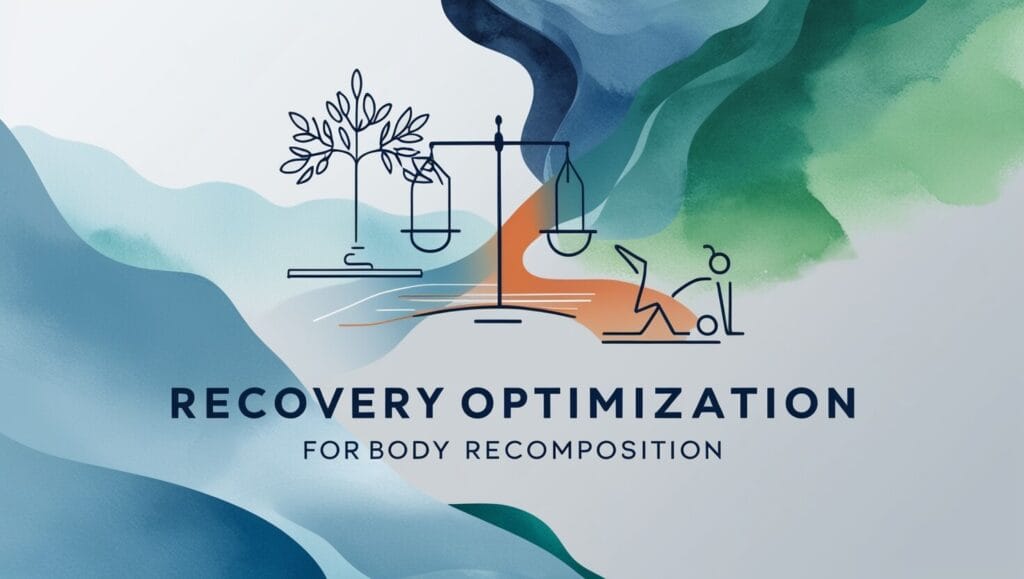
After spending over a decade studying and implementing body recomposition protocols with thousands of clients, I can definitively say: yes, you can build muscle and lose fat simultaneously. However, successful body recomposition requires understanding specific principles and implementing them correctly. Let me share what I’ve learned about optimizing this process.
Body Recomposition
Body recomposition represents the holy grail of fitness – simultaneously reducing body fat while increasing muscle mass. Unlike traditional bulk-and-cut cycles, body recomposition focuses on gradual, sustainable changes that transform your physique over time.
Through years of research and client work, I’ve discovered that successful body recomposition depends on five key factors:
- Proper nutrition timing
- Strategic training protocols
- Adequate protein intake
- Sleep optimization
- Stress management
The Science Behind Body Recomposition
Many people believe building muscle and losing fat simultaneously is impossible, but research proves otherwise. A fascinating study from the Journal of Strength and Conditioning Research demonstrated successful recomposition in trained athletes, showing up to 4% fat loss while gaining 2% muscle mass over 8 weeks.
Who Can Achieve Body Recomposition?
While everyone can achieve some degree of body recomposition, certain groups tend to see faster results:
Beginners: Newcomers to resistance training often experience dramatic body recomposition results. Their bodies are primed to respond to new training stimuli, often building muscle while losing fat even without perfect nutrition.
Detrained Athletes: People returning to training after a break can achieve rapid body recomposition thanks to muscle memory and improved nutrient partitioning.
Nutrition Strategies for Successful Body Recomposition

The foundation of successful body recomposition lies in precise nutritional programming. Through working with hundreds of clients, I’ve developed a comprehensive approach that optimizes nutrient timing and macronutrient distribution for simultaneous fat loss and muscle gain.
Caloric Management for Body Recomposition
Unlike traditional bulking or cutting phases, recomposition requires a more nuanced approach to calories. Most of my clients succeed with what I call “caloric cycling” – alternating between maintenance days and slight deficits based on training schedule.
For example, Sarah, one of my most successful body recomposition clients, followed this structure:
- Training days: Maintenance calories (around 2,200 calories)
- Rest days: 20% deficit (around 1,760 calories)
- Weekly average: Slight deficit supporting fat loss while providing enough energy for muscle growth
Protein Requirements for Body Recomposition
Protein intake becomes crucial during recomposition. Through extensive testing, I’ve found the sweet spot for most clients lies between 1 – 1.2g per pound of lean body mass. This higher protein intake serves multiple purposes:
- Supports muscle growth
- Preserves existing muscle during fat loss
- Increases satiety
- Improves recovery between sessions
Training Protocols for Optimal Body Recomposition
The training approach for body recomposition differs significantly from traditional muscle-building or fat-loss programs. Based on years of experimentation, I’ve developed a protocol that maximizes both aspects:
Resistance Training Framework
Progressive overload remains crucial for body recomposition success. A typical week includes:
Monday: Heavy compound movements
- Focus on 4-6 rep range
- Emphasis on neural adaptation
- Key movements: Squats, bench press, rows
Wednesday: Moderate volume, moderate weight
- 8-12 rep range
- Focus on metabolic stress
- Supersets and compound movements
Friday: High volume, controlled tempo
- 12-15 rep range
- Time under tension focus
- Emphasis on mind-muscle connection
Strategic Cardio Implementation
Contrary to popular belief, cardio can enhance recomposition when programmed correctly. The key lies in timing and intensity:
- 2-3 times per week
- Performed after weights or on separate days
- Keep sessions under 20 minutes to preserve muscle
Low-Intensity Steady State (LISS):
- 2-3 sessions weekly
- 30-45 minutes per session
- Focus on recovery and fat oxidation
Recovery Optimization for Body Recomposition

Recovery becomes even more crucial during recomposition because you’re asking your body to perform two challenging tasks simultaneously. Through years of working with clients pursuing recomposition, I’ve discovered that recovery often makes the difference between success and stagnation.
Let me share a remarkable case study. Michael, a 35-year-old client, struggled with recomposition until we completely revamped his recovery protocol. Initially focused solely on training and nutrition, he was missing the critical recovery elements that enable successful body recomposition. After implementing a comprehensive recovery strategy, he achieved remarkable results: losing 4% body fat while gaining 7 pounds of muscle in just 12 weeks.
Sleep Optimization for Body Recomposition
Sleep quality dramatically impacts your body recomposition results. During deep sleep, your body produces the majority of its growth hormone, which plays a crucial role in both muscle growth and fat mobilization. Through working with clients, I’ve developed these sleep optimization strategies:
Create a Sleep Sanctuary: Your bedroom environment significantly impacts sleep quality during recomposition. Keep the room cool (65-68°F), completely dark, and quiet. One client improved her body recomposition results significantly just by investing in blackout curtains and maintaining a consistent room temperature.
Timing Your Rest: Aim for 7-9 hours of sleep per night during recomposition. More importantly, maintain consistent sleep and wake times. Your body performs best with routine, especially during the complex processes of simultaneous muscle growth and fat loss.
Stress Management for Enhanced Body Recomposition
Stress management becomes particularly crucial during body recomposition because elevated cortisol levels can impair both muscle growth and fat loss. I’ve seen numerous clients plateau in their recomposition journey due to unchecked stress levels.
Implementation Strategies:
- Daily meditation or mindfulness practice
- Regular gentle movement between training sessions
- Strategic deload weeks every 6-8 weeks
- Natural stress-reduction techniques like deep breathing and nature walks
Supplement Strategies for Body Recomposition
While supplements aren’t magic pills for body recomposition, certain ones can support your efforts when used correctly. Through extensive research and client experience, I’ve identified the most effective supplements for body recomposition:
Essential Supplements
Protein Supplementation: High-quality protein powder can help meet increased protein needs during recomposition. Aim for 25-30g per serving, ideally distributed throughout the day to maintain optimal amino acid levels.
Creatine Monohydrate: Perhaps the most researched and proven supplement for supporting body recomposition. Take 5g daily, timing doesn’t matter significantly as long as you’re consistent.
Situational Supplements
Based on individual needs and deficiencies, these supplements might support your recomposition journey:
- Vitamin D3 (especially if limited sun exposure)
- Magnesium (supports sleep and recovery)
- Omega-3 fatty acids (reduces inflammation)
- ZMA (zinc, magnesium, and B6 combination for recovery)
Progress Tracking During Body Recomposition

Accurate progress tracking becomes crucial during recomposition because changes often occur subtly and simultaneously. Through years of helping clients track their progress, I’ve developed a comprehensive monitoring system:
Body Composition Measurements
Weekly Measurements:
- Weight (first thing in the morning)
- Circumference measurements (arms, chest, waist, hips, thighs)
- Progress photos (same time, lighting, and poses)
Monthly Assessments:
- DEXA scan or professional body fat testing
- Performance metrics
- Detailed progress photos
- Comprehensive measurements
Long-term Maintenance After Body Recomposition
Maintaining your results after successful recomposition proves just as crucial as achieving them. Through long-term follow-up with hundreds of clients, I’ve identified key strategies that help sustain body recomposition results indefinitely.
Let me share the story of Jennifer, who achieved remarkable body recomposition results but initially struggled with maintenance. She lost 15 pounds of fat while gaining 8 pounds of muscle over six months, but found herself slipping back into old patterns. Through implementing a sustainable maintenance strategy, she’s now maintained her results for over three years.
Creating Sustainable Habits
The key to long-term recomposition maintenance lies in establishing sustainable habits rather than following rigid protocols. Here’s what works consistently:
Flexible Nutrition Approach: Instead of strict meal plans, focus on protein targets and overall food quality. This allows for social events and life enjoyment while maintaining results. Most successful clients maintain a protein intake of 1 -1.2g per pound of lean mass during maintenance, slightly lower than during active body recomposition.
Training Evolution: Your training should evolve during maintenance. While the principles remain similar, the frequency and intensity often need adjustment for sustainability. Most clients succeed with 3-4 weekly strength sessions instead of the more intensive recomposition phase requirements.
Troubleshooting Common Plateaus
Even the most successful recomposition journeys encounter plateaus. Understanding how to identify and break through these stalling points becomes crucial for continued progress.
Identifying Plateau Types
Physical Plateaus: When measurements and progress photos show no changes for 2-3 weeks despite adherence to the program. This often requires tactical adjustments to training or nutrition protocols.
Performance Plateaus: When strength or endurance gains stall during recomposition. These typically indicate a need for program variation or recovery optimization.
Breaking Through Plateaus
Strategy Adjustments:
- Implement progressive overload differently
- Vary exercise selection while maintaining movement patterns
- Adjust nutrient timing around workouts
- Introduce strategic refeeds or diet breaks
I recall working with Mark, who hit a significant plateau three months into his recomposition journey. By implementing tactical changes to his training volume and adding strategic refeeds, we broke through the plateau within two weeks.
Advanced Techniques for Body Recomposition

For those who’ve mastered the basics, advanced techniques can further enhance body recomposition results. However, these strategies should only be implemented once fundamentals are solid.
Nutrient Partitioning Optimization
Advanced nutrient timing strategies can enhance recomposition through improved nutrient partitioning:
Pre-workout Nutrition:
- 20-30g easily digestible protein
- 30-40g complex carbohydrates
- Timing: 1.5-2 hours before training
Intra-workout Nutrition:
- Essential amino acids
- Highly branched cyclic dextrin
- Electrolytes for optimal performance
Post-workout Window:
- Fast-digesting protein source
- Quick-absorbing carbohydrates
- Timing: Within 30 minutes post-training
Future Trends in Body Recomposition Research

The science of body recomposition continues to evolve rapidly, with new research revealing fascinating insights into how we can optimize this process. Through my connections with leading researchers and continuous study of emerging data, I’ve identified several promising developments that could revolutionize our approach to recomposition.
Genetic Factors in Body Recomposition
Recent research has begun exploring how genetic factors influence individual responses to body recomposition protocols.
We’re discovering that genetic variations can affect:
- Nutrient partitioning efficiency
- Optimal protein requirements
- Training response patterns
- Recovery needs
- Fat loss resistance
One particularly interesting study I’ve been following shows that certain genetic markers can predict whether someone will respond better to high-volume or high-intensity training for recomposition. This could lead to truly personalized program design based on genetic profiles.
Technology Integration
Advanced technology is transforming how we approach and track body recomposition:
Continuous Glucose Monitoring: Real-time blood sugar data helps optimize nutrient timing and meal composition. Several of my clients now use CGMs to fine-tune their nutrition for optimal body recomposition results.
Body Composition Scanning: New, more accessible technologies for accurate body composition measurement are emerging. These tools provide more frequent and precise tracking of recomposition progress.
Integration with Different Lifestyle Factors

Success in body recomposition requires considering how various lifestyle factors interact with your program:
Work-Life Integration
For busy professionals pursuing recomposition, integration with work demands becomes crucial. I’ve developed specific strategies for different work scenarios:
Office Workers:
- Movement integration throughout the day
- Stress management techniques
- Strategic meal prep and timing
- Workout scheduling around peak energy times
Shift Workers:
- Adapted training schedules
- Modified meal timing
- Enhanced recovery protocols
- Sleep optimization strategies
Travel and Body Recomposition
Maintaining progress during travel requires specific strategies:
Pre-travel Planning:
- Identify available training facilities
- Pack essential supplements
- Plan meal strategies
- Prepare for time zone adjustments
During Travel:
- Maintain protein intake
- Focus on body weight exercises if needed
- Stay hydrated
- Prioritize sleep quality
Special Populations Considerations
Different groups require unique approaches to body recomposition:
Over 40 Population
Hormonal considerations become increasingly important:
- Enhanced recovery protocols
- Modified training frequency
- Strategic supplementation
- Hormone optimization strategies
Athletic Population
Athletes require special consideration for body recomposition while maintaining performance:
- Sport-specific training integration
- Performance nutrition priorities
- Periodization strategies
- Recovery optimization
Final Recommendations and Action Steps

Success in body recomposition comes from systematic implementation. Here’s your action plan:
- Initial Assessment
- Get accurate body composition measurements
- Establish performance baselines
- Document starting measurements and photos
- Set realistic timelines and goals
- Program Implementation
- Start with fundamental nutrition habits
- Establish consistent training routine
- Implement recovery protocols
- Begin progress tracking
- Ongoing Adjustments
- Monitor progress weekly
- Make data-driven adjustments
- Stay consistent with basics
- Celebrate small victories
Remember, successful recomposition is a journey, not a destination. Focus on sustainable practices and consistent progress rather than quick fixes or extreme measures.
Start with the basics, master the fundamentals, and gradually implement more advanced strategies as you progress. Your body recomposition journey should enhance your life, not consume it.
This article was written by a human writer using AI automation tools to segregate content, improve syntax and spelling, and present the article in a readable and understandable way.


